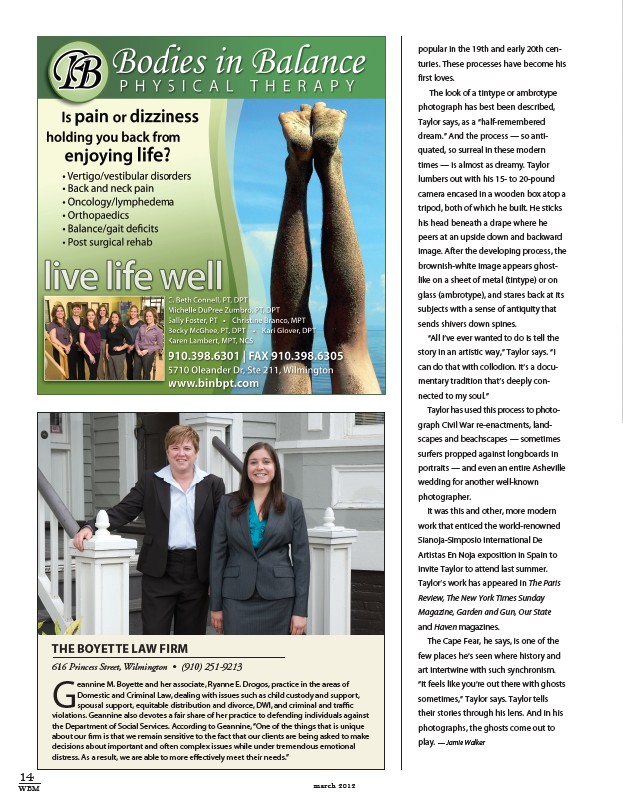
The Boyette Law Firm
616 Princess Street, Wilmington • (910) 251-9213
G eannine M. Boyette and her associate, Ryanne E. Drogos, practice in the areas of
Domestic and Criminal Law, dealing with issues such as child custody and support,
spousal support, equitable distribution and divorce, DWI, and criminal and traffic
violations. Geannine also devotes a fair share of her practice to defending individuals against
the Department of Social Services. According to Geannine, “One of the things that is unique
about our firm is that we remain sensitive to the fact that our clients are being asked to make
decisions about important and often complex issues while under tremendous emotional
distress. As a result, we are able to more effectively meet their needs.”
14
WBM march 2012
popular in the 19th and early 20th centuries.
These processes have become his
first loves.
The look of a tintype or ambrotype
photograph has best been described,
Taylor says, as a “half-remembered
dream.” And the process — so antiquated,
so surreal in these modern
times — is almost as dreamy. Taylor
lumbers out with his 15- to 20-pound
camera encased in a wooden box atop a
tripod, both of which he built. He sticks
his head beneath a drape where he
peers at an upside down and backward
image. After the developing process, the
brownish-white image appears ghostlike
on a sheet of metal (tintype) or on
glass (ambrotype), and stares back at its
subjects with a sense of antiquity that
sends shivers down spines.
“All I’ve ever wanted to do is tell the
story in an artistic way,” Taylor says. “I
can do that with collodion. It’s a documentary
tradition that’s deeply connected
to my soul.”
Taylor has used this process to photo-
graph Civil War re-enactments, landscapes
and beachscapes — sometimes
surfers propped against longboards in
portraits — and even an entire Asheville
wedding for another well-known
photographer.
It was this and other, more modern
work that enticed the world-renowned
Sianoja-Simposio International De
Artistas En Noja exposition in Spain to
invite Taylor to attend last summer.
Taylor’s work has appeared in The Paris
Review, The New York Times Sunday
Magazine, Garden and Gun, Our State
and Haven magazines.
The Cape Fear, he says, is one of the
few places he’s seen where history and
art intertwine with such synchronism.
“It feels like you’re out there with ghosts
sometimes,” Taylor says. Taylor tells
their stories through his lens. And in his
photographs, the ghosts come out to
play. — Jamie Walker